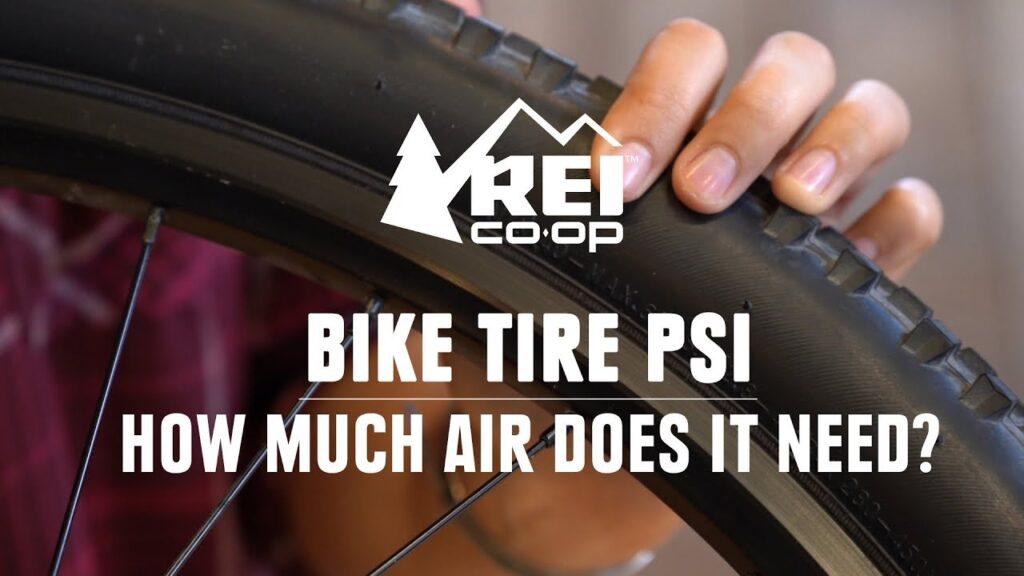Bike tires typically have between 30 and 60 psi. The amount of psi will depend on the type of bike, the terrain, and the rider’s preference.
Bike tires are typically inflated to between 30 and 60 PSI, with most road bikes being closer to the higher end of that range and mountain bikes usually sitting closer to the lower end. The specific number is usually determined by the rider’s weight, terrain, and desired ride quality.
For a given rider weight, there will be a range of PSI values that will provide a safe, comfortable ride.
Going too low can result in a less stable ride and more flats, while going too high can make for a jarring ride. The best way to find your ideal PSI is to experiment on different types of terrain with different tire widths until you find what works best for you.
Bike Tire PSI: How Much Air Should You Put in Your Bike Tire? || REI
What Psi Should My Bike Tires Be?
There’s no definitive answer to this question as the ideal PSI for your bike tires will depend on a number of factors, including the type of bike you’re riding, the terrain you’ll be riding on and your personal preferences. However, there are some general guidelines you can follow when inflating your bike tires.
For road bikes, most riders prefer tires that are inflated to between 80 and 130 PSI.
If you’re going to be doing a lot of climbing on hilly terrain, you might want to err on the higher end of that range. For mountain bikes, many riders opt for lower pressures in the 30 to 50 PSI range. This provides better traction and comfort on rough trails.
Ultimately, it’s best to experiment with different tire pressures to see what works best for you. Just keep in mind that under-inflated tires can make for a more difficult ride, while over-inflated tires are more susceptible to punctures.
What is the Air Pressure for a 26 Inch Bike Tire?
Assuming you are asking about a 26″ mountain bike tire, they typically range from 30-60 PSI. For a more detailed answer, it really depends on the width of your tire as well as the terrain you’ll be riding on. A wider tire will need less pressure because it has more contact with the ground, while a narrower tire will need more pressure because it has less contact with the ground.
If you’re riding on smooth pavement, you’ll want to err on the higher end of that range (around 60 PSI), but if you’re riding on rougher terrain, you’ll want to be closer to 30 PSI.
Is 40 Psi Good Tire Pressure?
Tire pressure is measured in pounds per square inch (psi). The recommended tire pressure for most passenger cars is 30-34 psi. Higher-end vehicles may have tires that require more pressure, usually around 35-40 psi.
However, it’s always best to consult your car’s owner manual to be sure.
Having too much or too little tire pressure can negatively affect your car’s performance. If the pressure is too low, the tires will flex more and generate heat, which can lead to a blowout.
Conversely, if the pressure is too high, the ride will be jarring and uncomfortable. Additionally, either extreme can decrease fuel efficiency and shorten the lifespan of your tires.
To maintain optimal performance and safety, it’s important to check your tire pressure regularly and inflate or deflate as needed to reach the ideal level.
You can do this at home with a handheld air gauge or by taking your car to a service station that has an air pump.
Is Bike Psi Same As Car Psi?
It’s a common misconception that bike PSI is the same as car PSI. In actuality, there are several key differences between the two. For one, car PSI typically ranges from 20-32, while bike PSI is usually 80-120.
Additionally, car tires are designed to be driven on smooth surfaces such as pavement, while bike tires need to grip rougher terrain like dirt or gravel. As a result, bike tires are often thicker and have more tread than car tires.
Due to these differences, it’s important to inflate your bike tires according to the manufacturer’s recommendations.
Overinflating can cause the tire to burst or blow out, while underinflating can lead to poor handling and decreased traction. Be sure to check your bike’s owner manual for specific inflation instructions before heading out on your next ride!

Credit: www.bikeradar.com
Bike Tire Psi Calculator
Bike Tire Psi Calculator
Do you know how much air pressure to put in your bike tires? It’s important to have the correct amount of air pressure in your tires, not too much and not too little.
Too much air pressure and your bike will be uncomfortable to ride, too little and your bike could get damaged or cause an accident. Use this Bike Tire Psi Calculator to determine the optimal air pressure for your bike tires based on tire width, terrain and riding style!
Mountain Bike Tire Psi
Mountain bike tires are typically inflated to lower pressures than road bike tires. The average mountain bike tire is inflated to between 20 and 30 psi, with some riders going as low as 10 psi for very rocky and technical terrain.
The benefits of running lower tire pressure on a mountain bike are twofold.
First, it provides more traction because the tire is able to conform to the ground surface more easily. Second, it helps absorb impact better, which protects the rider from getting bounced around too much on rough terrain.
Of course, there are trade-offs to running lower tire pressure.
The main one is that the tire is more likely to flat because there’s simply less material holding up against sharp objects. But if you’re careful about where you ride and what you hit, you can still enjoy all the benefits of low-pressure mountain biking without too much worry about flats.
Road Bike Tyre Pressure Calculator
If you’re like most road cyclists, you probably have a general idea of what range of tyre pressures are best for your bike. But did you know that there’s a tool that can help you calculate the perfect tyre pressure for your specific bike and riding conditions? It’s called a road bike tyre pressure calculator, and it can be a valuable asset in helping you get the most out of your rides.
Here’s how it works: simply enter in some basic information about your bike and riding conditions, and the calculator will do the rest. It will take into account factors such as tyre width, rim width, rider weight, and even air temperature to come up with recommended pressures for both front and rear tyres.
One thing to keep in mind is that these recommendations are just that – recommendations.
Every rider is different, so it’s important to experiment to find what works best for you. But if you’re looking for a starting point, a road bike tyre pressure calculator can be a helpful tool.
700C Bike Tire Pressure
700C bike tire pressure can vary depending on the type of bike, terrain, and rider weight. For example, a lightweight road bike ridden on smooth pavement would require less tire pressure than a heavier mountain bike ridden on rough trails. Generally speaking, 700C tires are inflated to between 80 and 130 PSI.
Schwinn Bike Tire Pressure
A bike’s tires are one of the most important parts of the bicycle, and proper tire pressure is essential to a good ride. Too much pressure and the ride will be uncomfortable, too little and the bike will be difficult to control. Here are some tips on how to achieve proper Schwinn bike tire pressure.
First, check your owner’s manual for recommended tire pressure. Most Schwinn bikes will have a range of acceptable pressures, so start in the middle of that range and adjust as needed. If you don’t have an owner’s manual, you can usually find the recommended pressure on a sticker affixed to the frame or fork.
Next, use a reliable pump to inflate your tires. A floor pump is ideal, but if you don’t have one handy, a hand pump or even a gas station air compressor will do. Just be sure not to overinflate – stop when you reach the upper end of the recommended range (or when the tire feels firm underfoot).
Once your tires are inflated, check them periodically throughout your ride to ensure they’re still at the correct pressure. If they start to feel soft or squishy, add more air until they’re firm again. With proper inflation, your Schwinn bike will provide years of trouble-free riding enjoyment!
Road Bike Tire Pressure
Road bike tire pressure is one of the most important aspects of bicycle maintenance. Proper tire pressure ensures that your bike rides smoothly and safely. Under-inflated tires can cause flats, while over-inflated tires can make your ride uncomfortable and increase the risk of a blowout.
To find the perfect tire pressure for your road bike, start by consulting your bike’s owner’s manual. If you don’t have the manual, you can usually find the recommended tire pressure range printed on the side of your tires. Once you know the ideal range, use a tire gauge to check and adjust your tire pressure as needed.
As a general rule of thumb, higher-pressure road tires require less air than lower-pressure mountain bike tires. For example, a 23mm road tire might be inflated to 100 psi, while a 35mm mountain bike tire might only need 30 psi. Use these numbers as a starting point and then fine-tune according to your personal preferences.
Keep in mind that different weather conditions can affect your ideal tire pressure. In hot weather, for instance, air expands inside the tire, so you may need to let out some air to maintain optimal pressure. Similarly, in cold weather or at high altitudes, air contracts inside the tire, so you may need to add more air to reach ideal levels.
Road Bike Tyre Pressure Calculator Continental
If you’re like most road cyclists, you probably have a lot of questions about tyre pressure. What’s the best tyre pressure for my bike? How do I find out what tyre pressure I should be using?
Do different tyres require different pressures?
Luckily, we have a tool that can help answer all of those questions – the Continental Road Bike Tyre Pressure Calculator.
This easy-to-use calculator will take into account your bike’s weight, tyre width, and desired riding conditions to recommend the perfect tyre pressure for you.
Plus, it includes recommendations for popular Continental road tyres so you can get started right away.
So whether you’re looking for the best tyre pressure for your next training ride or race, or just want to learn more about how tyre pressure affects your ride, be sure to check out the Continental Road Bike Tyre Pressure Calculator!
Conclusion
Bike tires typically range in psi from 30 to 60. The ideal psi for a bike tire depends on the rider’s weight, the terrain, and the type of bike. For example, a lightweight rider on a road bike will want a higher psi than a heavyweight rider on a mountain bike.

